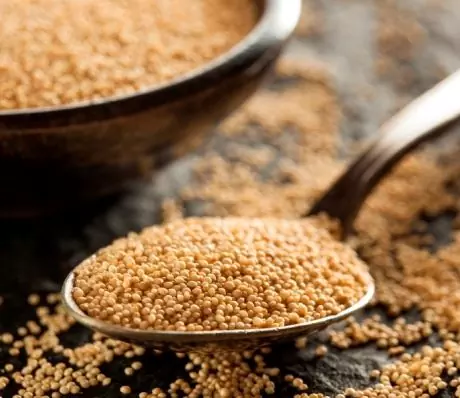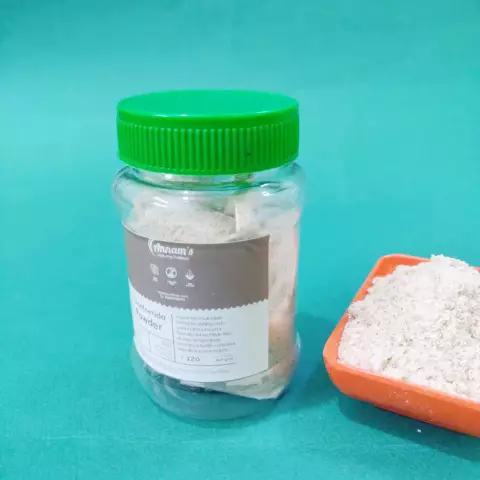- Author Rachel Wainwright [email protected].
- Public 2023-12-15 07:39.
- Last modified 2025-11-02 20:14.
Nasturtium
Nasturtium is a summer ornamental plant from the Capuchin family, constantly blooming until the first frost. The most common nasturtium has red-orange or fiery orange flowers. Less common are pink and yellow flowers.

There are two types of plants: dwarf, or low bush, reaching a height of 25 centimeters, which blooms more abundantly and brightly, as well as high nasturtium, with creeping shoots up to 1.5 meters in length.
The plant loves moderately moist soil, well fertilized. Nasturtium does not tolerate fresh manure, excess moisture and lime. However, the plant also does not tolerate a lack of moisture. On an overly fertilized soil, the plant stops blooming, and the leaves, on the contrary, begin to develop rapidly.
Nasturtium is propagated by seeds. For early flowering at the beginning of May, seeds are sown in pots 2-3 pieces and put under a film in a greenhouse. It is undesirable to sow seeds in boxes, since the plant does not tolerate transplanting well. After the end of the frost, nasturtium is planted in open ground. If the weather is warm, then the seeds can be sown directly into the soil.
Caring for nasturtium consists in regular feeding and watering. Dwarf nasturtium is great for lining paths and curbs. High nasturtium is often planted near gazebos, balconies, and building facades.
Composition and useful properties of nasturtium
Few people know that in addition to its beautiful appearance, nasturtium has remarkable medicinal properties. In South America, home to the plant, nasturtium is used in the treatment of many diseases. The plant also does not ignore European medicine.
All aerial parts of nasturtium contain a large amount of ascorbic acid. Its content in plant stems reaches 100-150 mg, and in leaves - up to 450 mg per 100 g. This is about the same as in black currant berries and vegetable peppers.
The beneficial properties of nasturtium lie in the content of sulfur and carotene, which act as a preventive measure for sclerosis and other diseases inherent in people of advanced age. There is a lot of potassium, iodine, phosphorus in the plant.
Nasturtium kills pathogenic microbes, stimulates the body's immune forces, and improves metabolic processes.
All parts of the plant are used for medicinal purposes. Leaves, for example, have a pronounced antiscorbutic effect. Nasturtium is used for influenza, diseases of the lungs and upper respiratory tract, as an anti-cold remedy, for chronic bronchitis. All this is due to the content of herbal antibiotics in the plant. The beneficial properties of nasturtium are used for metabolic disorders, gallstone and kidney stone diseases, for inflammatory diseases of the lymph nodes, as a laxative. The plant is used for male and female menopause. Dried flowers and leaves of nasturtium effectively relieve depression, relieve irritability and feelings of depression.
To prepare the infusion, you need to take 1 tablespoon of crushed nasturtium leaves, pour one glass of boiling water, leave for half an hour and strain. Take a third of a glass of infusion three times a day.
In Western Europe, a wine infusion made from nasturtium leaves is widespread. To prepare it, you need to fill a liter jar to the top with fresh plant leaves and fill them with dry white wine. Insist in a dark place for two weeks, drain. It is necessary to take wine infusion one teaspoon three times a day before meals. This infusion is especially useful when weakening the vitality of the body.
For diseases of the urinary tract and kidneys, including urolithiasis, a decoction of the whole plant is useful. To prepare it, you need to pour 0.5 liters of boiling water over one tablespoon of buds, fruits and leaves of nasturtium and heat for fifteen minutes in a water bath. After that, the broth is infused for 30-40 minutes and filtered. Take half a glass three times a day.
In chronic bronchitis, nasturtium juice is useful, which is taken one tablespoon three times a day. For this purpose, an alcoholic tincture is also prepared from the whole plant. To prepare it, take 1.5 tablespoons of seeds, buds and leaves of nasturtium, pour in one glass of vodka and insist for two weeks in a dark place. Take alcohol tincture 25 drops three times a day.
Infusion of nasturtium flowers is successfully used for diseases of the cardiovascular system.
The beneficial properties of nasturtium also help in the treatment of stomatitis. For this purpose, the following broth is prepared: 1 tablespoon of flowers and leaves of the plant is poured with 1 glass of boiling water and heated in a water bath for half an hour. Filter the broth and add 1 teaspoon of honey to it. Rinse the mouth cavity and throat with broth for angina and stomatitis.
Juice is made from the leaves of nasturtium, which is used externally for scabies and itching. Also, the juice of the leaves of the plant is used for hair loss. Alcohol tincture of nettle and nasturtium, or a decoction of the fruits and leaves of nasturtium, are still good for hair loss.

The use of nasturtium in cooking
In addition to its many beneficial properties, nasturtium is also widely used in cooking. Unripe seeds, fresh leaves and firm flower buds of the plant are used for food.
In South America, the plant is used as a spice, since all its parts have a specific taste and aroma. In English-speaking countries, nasturtium is used to make vitamin drinks and salads.
Fresh leaves, unripe seeds, and hard flower buds have a pleasant, pungent taste, which is why they are often seasoned with meat dishes and salads. Green fruits of the plant and flower buds are pickled with vinegar and dill, and vinegar is prepared from nasturtium flowers, which has a peculiar taste.
The nasturtium petals are ground to a pasty state with the addition of garlic, salt and mayonnaise and used for sandwiches.
Fresh flowers are used to decorate culinary dishes with fruit casseroles and vegetable platters. Dried flowers are added to homemade wines. Also, a very aromatic tea is obtained from dried flowers.
YouTube video related to the article:
Found a mistake in the text? Select it and press Ctrl + Enter.






